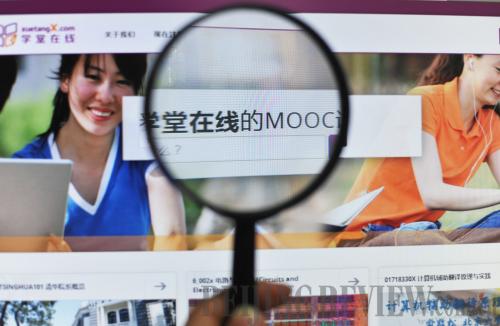|
 |
|
MASSIVE, OPEN AND ONLINE: XuetangX, a large platform for massively open online courses in China, opens on October 10 (IC) |
Cai Shiyu narrowly missed a position at China's highly ranked Tsinghua University, his first choice, because his score in this June's national college entrance examination came up short by a few points. Currently enrolled in another university in Beijing, Cai was relieved to discover it is still possible for him to learn from the best professors from Tsinghua University and other world-renowned universities through "massively open online courses" (MOOCs).
"Anyone can take any course that they want as long as they have a computer and access to the Internet," Cai said. He firmly believes MOOCs, like traditional college courses, allow students to refine and master new skills and obtain knowledge that can be applied in real-world situations.
"There are no visa requirements, no tuition charges and no time constraints when taking a MOOCs course, even though the university may be in another country," said Zhang Zheng, Vice President of Microsoft Research Asia.
Different learning model
In the past decade or so, online teaching has gone through three distinct phases, namely Open Course Ware, video courses and the more recent MOOCs.
Rather than simply offering course materials such as videos and PowerPoint presentations online, MOOCs feature almost all the elements of conventional courses such as handouts, in-class questions and answers, quizzes, homework assignments and even exams. After completing a course, it is possible to be awarded a certificate—though it may not count toward course credit at an actual higher learning institution.
Now Cai is addicted to MOOCs because the courses are immersive and engaging. "Previously, video-taped courses were not so interactive and could not ensure the attentiveness of students," Cai said.
After the video clip for a course is played, it will stop and instructor's questions appear on the screen. Only after answering the questions correctly, can a student move ahead. In a course, there might be dozens of such stops. "Sometimes, the video stops once every three minutes, so it is difficult for me to divert my attention to other things even for a minute," Cai said.
Catching on
MOOCs are becoming rapidly popular all over the world in a sweeping global trend.
Coursera, a leading MOOCs platform founded by Stanford University computer science professors Andrew Ng and Daphne Koller, currently offers hundreds of courses from more than 60 internationally renowned universities. Enrollment on the site has been growing at a staggering pace. According to The Wall Street Journal, Coursera's accumulated enrollment had reached 2.8 million students by the end of March and the number had nearly doubled by October, reaching 5 million.
Alongside Coursera, there are two major MOOCs platforms currently offering courses online: edX and Udacity.
EdX was developed and launched by Harvard University and the Massachusetts Institute of Technology (MIT) in May 2012 and boasts 1.3 million learners to date.
Udacity, founded by Sebastian Thrun, David Stavens, and Mike Sokolsky—also professors from Stanford University—is the third largest MOOCs platform currently in operation with more than 700,000 registered learners last year. On their website they state, "By making high-quality classes affordable and accessible to students across the globe: Udacity is democratizing education."
On October 10, XuetangX, a MOOCs platform in China, began operations. It features courses from a range of leading Chinese higher learning institutions, including Tsinghua University and Peking University. In attendance at the opening ceremony was Anant Agarwal, President of edX—the learning platform upon which XuetangX is based.
In May, Tsinghua University began to offer courses on edX.org, becoming the first university on China's mainland to do so. However, XuetangX is independent from edX.org, and was built by Tsinghua University's computer science team using the open-source code repository developed, and made freely available, by edX.
The first batch of courses available on XuetangX also includes Principles of Electric Circuits, History of Chinese Architecture and three other courses offered by Tsinghua University, MIT's Circuits and Electronics and Peking University's Principles and Practices of Computer-aided Translation.
| 